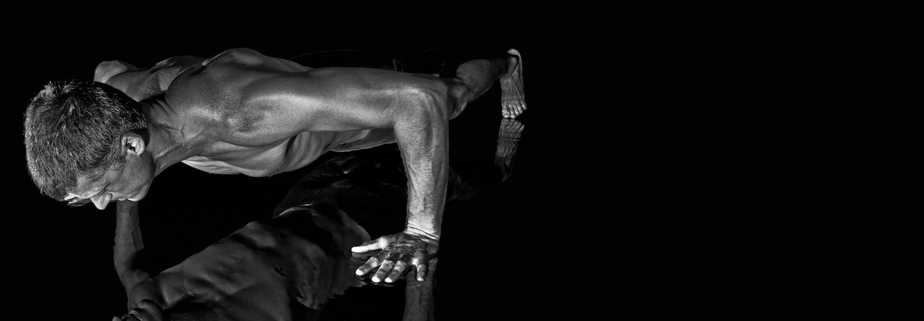One of the most fundamental exercises in the calisthenics repertoire is the push up. If you want to build strength through bodyweight exercises then get prepared to perform a lot of push ups on a regular basis.
The benefit of doing push ups is that they will help you build strength in your shoulders, chest and arms as well as toning your core and back muscles.
In this article, I’ll walk you through this simple yet effective exercise. I’ll explain exactly how to do a push up properly and point out common mistakes and how to avoid them. After you have read this article you will be able to perform the perfect push up.
1. Push Up: Perfect Form
The key to success, first and foremost, is ensuring each push up is executed using correct form. This is crucial. Correct form will ensure the effectiveness of the push up for building strength and toning muscle. It will also help you to avoid injuring your joints, muscles and tendons.
Using correct technique every time will also allow you to accurately measure your performance. If you complete your push ups differently from one workout to the next, there is no way of telling if you are actually getting stronger. By sticking to the following points you will be able to carry out a push up in the same manner every time you workout. This way you can accurately calculate improvements.
I cannot stress this enough; success with push ups is based on how you do them, not how many you do. For this reason, I always advise focusing on your form before worrying about how many reps you are capable of.
So what constitutes perfect form when it comes to push ups?
2. Positioning for a Push Up
1. Place your hands slightly wider then shoulder width apart – ‘slightly’ is the operative word here, your hands should still be underneath your shoulders before you begin.
2. Hands turned outwards – Some calisthenics trainers suggest angling your hand so that the middle finger points straight ahead; others suggest placing your hands a 45 degree angel from the body. I believe the exact position is rather irrelevant and you should focus on what is comfortable. However, be sure to avoid turning your hands inwards as this can lead to your elbows drifting away from your sides, which brings us to point number 3…
3. Keep you elbows close to your sides – Don’t allow your elbows to flare out wildly. Keep them tucked in. Also, makes sure your forearms are directly above your wrists, not ahead or to the side. Failure to do so results in extra stress being placed on the elbow and reduces the involvement of your chest and shoulders in the exercise.
4. Place your feet shoulder width apart in a manner that feels comfortable – This positioning is best for traditional push ups. During some push up variations, such as a one arm push up, you will start with a wider foot stance.
5. Keep your head up and eyes forward – When preparing to perform a push up you are aiming to create a straight line with your body. This line should be maintained throughout the push up. Keep your head up and eyes straight ahead helps to maintain that line. This position will mean that the first part of your head to touch the floor is your chin, rather than your nose.
6. Maintain a strong core – As with keeping your head up, maintaining a strong core is essential for keeping your body in line. This means not allowing your back to sag down or your butt to stick up. If you find this difficult then I suggest actively engaging your abs and gluts to pull your body into line.
3. Start your Push Up
Now that you are in the perfect starting position you can begin the push up:
Step 1: From the position described above, hands shoulder width apart, elbows tucked, head up and body in line, carefully lower yourself down until your elbows form a 90 degree angle or slightly less. The exact angle will depend on your experience and strength but aim for 90 degrees as a minimum. Preferably your chest will touch the ground. If you prefer you can use your chin touching the ground as a marker, though I personally prefer the chest as it is a more consistent indicator.
Step 2: While lowering yourself down, keep your elbows close to your body. If you feel them shifting outwards this means you’re tiring from the effort or simply losing focus.
Step 3: Having lowered yourself to the optimum position, the point at which your chest touches the floor, push yourself upwards as hard as you can. You have finished the movement when you return to the starting position with your arms straight.
Repeat the process until you are tired or begin to lose your form. It may sound as if I’m repeating myself here, but I’ll remind you again, 5 push ups performed correctly are more effective than 20 push ups done poorly. As soon as you feel yourself slipping – an elbow swings out, your head drops, whatever – stop doing push ups. Note down how many you did and end your work out for the day.
4. Measuring your Push Ups to Track Improvement
The only way to know if you are getting better at something is to measure your performance. Now that you can do a push up properly it’s time to start counting. Doing push ups the same every time means you can accurately record the number of push ups you are capable of doing from one workout to the next.
Giving yourself a goal can be motivating but make sure it’s realistic. If you’ve only just started doing push ups doing set your target as 4 sets of 50 push ups by next week. You simply aren’t going to achieve it. Pick something achievable and then work towards it gradually and consistently.
Common push up routines are based around sets of 4. For example, you perform 4 sets of 10 push ups with a break of 2 mins between each set.
To be honest, the length of your rest break is fairly arbitrary. The key is keeping it consistent. If you are going to take a 30 second break between sets make sure it is 30 seconds, EVERY TIME. If you don’t stick to the workout formula you have chosen then measuring your performance will be difficult.
If you’re not sure how many reps you should do per set try this: do as many push ups as you can, go all out, push yourself to the limit – of course using your perfect form as always. Make sure you count while doing this. Once you’ve recovered from exhaustion, write down how many push up you did. Take that number and halve it. The number you’re left with is how many push ups you should aim to complete with each set.
5. Can’t do a Push Up? Here’s what to do:
If you are struggling to knock out even a single push up, don’t lose hope! All is not lost.
Rather than vainly trying to do a standard push up focus instead on wall push ups. This is where you place your hands against a wall and your feet a yard or two away from the wall. This will result in you leaning into the wall.
As with a normal push up check your form! Is your body in a straight line? Are your hands shoulder width apart and your hand angled outwards? If so, you can lower yourself towards the wall until your chin touches the surface.
Repeat this exercise until you can perform several sets of 15-20 reps.
At this point you may graduate to the incline push up. Find a table, a park bench or a similar waist-high surface. Assume the push up position with your hands placed on the edge of your surface area. Once again perform a push up.
The wall push up and incline push up offer gentler ways of building the muscles you need to perform an ordinary push up. Once you are competent with these two exercises you can once again attempt a normal push up. If you are still struggling you can also try doing push ups on your knees.
6. Stretching for a Push Up
Doing proper push ups can put strain on your wrists. For this reason I would advise doing some simple wrist stretches before doing push ups.
Begin by simply twirling your wrists around in circles, ensuring you achieve the fullest motion possible.
Then, with one arm extended, use one hand to pull back on the fingers of your extended arm. This should result in your fingers facing upwards and the stretch running across the bottom of your wrist. To balance this stretch, follow on with the reverse. Point your hand downwards, pressing upon the back of your hand with your other hand. Repeat this stretch on both wrists.
You may also wish to do a simple triceps stretch with your arm behind your head and your hand reaching down your back, along with some chest stretches.
7. Push Up Variations
So far I have focused on describing how to do a standard push up. If you feel that you’ve mastered the basic push up then you might want to try some more advanced variations.
Some of these variations are extremely challenging. If you’re new to calisthenics then you should probably stop reading now and concentrate on perfecting your push up. Though if you are curious about what lies in store for you further along the road, then stick around!
There are countless push up variations and because I don’t have the time to go through all of them today I have selected just a few of my favorites. If you are all interested I can do a more detailed post on push up variations later.
1. The Spider Man Push Up: Intermediate
This exercise is so named for making you look like a horizontal spider man while you do it. As you lower yourself to the ground, bring your left leg off the floor, bending the knee and bringing your leg up towards your chest. This shifts your weight to the right side adding extra resistance. Repeat the movement with your right leg off the ground.
2. The Hindu Push Up – Intermediate
Begin in the downward dog position. For those of you not familiar with this yoga pose, this means leaning down and placing your hand on the floor in front of you while keeping your feet on the ground. You will form a big arc with your body, with your butt sticking up in the air, your head level with your arms and eyes looking backwards and down.
To complete the push up, lower yourself down while simultaneously pushing forward on your toes and lifting your chest and head up before returning to your downward dog position.
3. Side to side Push Ups – Intermediate
This push up involves breaking two of the golden rules of correct form. Begin with you arms further away from your body than should width and point your hands outwards so that your fingers are facing away from your body. Start with your feet close together.
Lower yourself down to one side and then up and down to the other side. This movement focuses the pressure on your chest and should leave you with a pleasant chest ache the following day.
4. The One-Arm Push Up – Advanced
Spread your legs out wide in order to give yourself extra stability. Put your hand close under your body and lower yourself down gradually before exploding back up into starting position.
5. Lelanne Fingertip Push Up – Advanced
This is an extremely difficult push up. It involves placing your hands out infront of you and then lifting your weight on your fingertips. The Lelanne Fingertip is an advanced push up that takes a lot of strength to complete.
6. Falling and Explosive Rebound Push Up – Advanced
From standing, fall forward into push up position. Complete the push up as normal and then explode upwards, propelling yourself back into standing position once again. Do not attempt this push up unless you have the appropriate strength. Otherwise you risk damaging yourself.
7. Forearm to Tricep Extension Push Ups – Advanced
Begin with your forearms facing inwards in front of your chest. Then lift your body by extending your arms until your weight is on your hands. This push up requires exceptional forearm strength.
To build my forearm strength try doing these push ups from a kneeling position. 3 sets of 15 with a 30 second break between sets, performed every other day.
8. Aztec Push Ups – Advanced
Once again, the Aztec requires explosive power to perform. Begin by doing an ordinary push up. Then, at the end of the upward motion push off into the air and bring your feet forwards so that you can touch them with your fingertips. Having touch your toes you must immediately straighten out your body in order to land in push up position once more.
8. Push Up Videos
For inspiration check out this incredible video demonstrating some of the push up variations I have discussed:
9. Push Up Workout Routine:
1. 4 sets: Spider Man Push Up – 2-5 reps
2. 4 Sets: Side to Side Push Up – 10 reps
3. 4 sets: ordinary push ups – 10 reps
Notice that harder push ups that require low reps per set are performed earlier on in the workout. The more continuous, repetitive sets are saved for the end. This is the optimum way to build muscle; starting with the hardest exercise and finishing with the easiest.
Try other workout routines here.
10. Improving your Push Up
Eat well – This goes without saying really. If you want to be good a push ups maintain a healthy diet. I would also advise eating a protein rich meal or taking a protein shake after any strenuous workouts.
Be consistent – Make sure you maintain your excellent push up technique. Always bear in mind that correct form is more important than total number of reps.
Take rest days – Some fitness trainers claim rest days aren’t necessary. I suggest taking a day off between exercises in order to let your muscles rebuild and strengthen. If you don’t do this your muscles will suffer from tiredness and you will find yourself working hard for very little visible improvement.
Congratulations, Now You Know how to do a Push Up!
There you have it! Modern Calisthenics’ ultimate guide to performing a proper push up. I hope you found it useful.
If you have questions about some of the points raised in this article please don’t hesitate to leave a comment, I promise to get back to you as quickly as is humanely possible.
Thom, Founder, Editor & Head Writer @ ModernCalisthenics.com



Hi Thom, I have been going to the gym for the last 12 months and I find it hard to keep myself motivated. So I have found it hard to keep up the schedule and sometimes don’t go to the gym for weeks. On the other hands calisthenic is much more enjoyable. I have been doing it for the last few weeks and I really like this form of exercise.
But my only concern is muscle isolation. When I am at the gym I know what muscles are exercised by each workout. But in body weight exercises I don’t find exercises that target specific muscles. Is muscle isolation possible in calisthenics?
Hi William, thanks for your question. For me, calisthenics is about building holistic strength. That means developing every single muscle in the body rather than focusing on specific, isolated muscles. Unlike traditional bodybuilding, which targets specific muscle groups and trains them for a single movement, calisthenics trains the whole body and develops a functional strength that can be applied in any situation. That said, there are exercises that focus more on one group of muscles than others. If you are looking to build arm strength focus on pull ups, whereas if you want to develop your chest do push ups. I hope that helps. All the best, Thom.